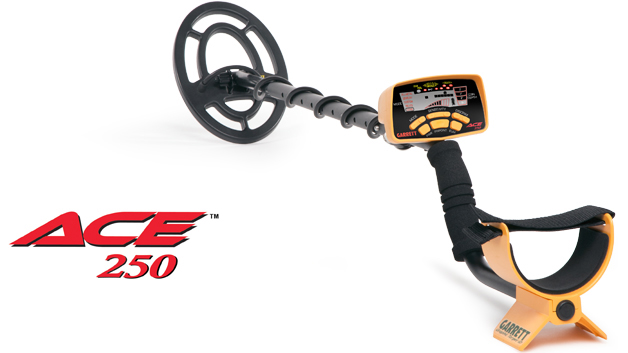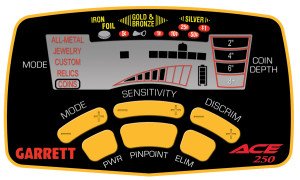The Garrett Ace 250 is a metal detector that is full on features and low on price. This is the first metal detector that I’ve ever owned so I thought that I would take the opportunity to share my experiences using the Garret Ace 250 with you.
If you’re anything like me, you probably spend a great deal of time thoroughly researching a product before spending your hard earned money on it. I can therefore only assume that this isn’t the first review of the Garrett Ace 250 that you’ve read as it’s been on the market for a few years now. I too read many product reviews for the Garrett Ace 250 before I purchased mine. One thing that most reviewers were quick to point out is that with the Ace 250 you are getting a lot of “bang for your buck.” For the sake of brevity, let me say here and now that I absolutely agree! With a list price of around $225 on Amazon, the Garrett Ace 250 comes packed with features that you would expect to find on a much more expensive metal detector.
Garrett Ace 250 Specifications
- Weight – 2.7 lbs
- Search Coil – 6.5 x 9 inches
- Frequency – 6.5 kHZ
- Warranty – 2 Year
- Adjustable Arm Cuff
- 1/4 inch Headphone Jack
- Large LCD Display
- Push Button Controls
- Five Search Modes (Builtin Discrimination Patterns)
- 12 Segment Adjustable Notch Discrimination
- Continuous Coin Depth Indicator
- Battery Condition Indicator
- Built-In Pinpointing
- Interchangeable ACE Series Search Coils
- Includes Training DVD
- Requires 4 AA Batteries
Garrett Ace 250 Look And Feel
The Garrett Ace 250 is a lightweight metal detector with a large, easy-to-read LCD screen. The arm cuff and shaft adjust easily, and the buttons on the control box can be operated single-handed. The padded grip makes the unit comfortable to hold for extended periods of time.
Garrett Ace 250 Basic Operation
Using The Preset Factory Modes
The Garrett Ace 250 comes with five preset factory discrimination patterns (modes) that can be accessed by pressing the mode button. The all metal mode operates just as the name implies, there is no discrimination, all metals will be detected. The jewelry mode will reject iron and foil but will detect all other metals. Custom mode allows the operator to save their discrimination settings even after the device is powered off. Relics mode will reject iron trash, and coin mode will reject most trash while retaining the ability to detect coins including the nickel.
I personally use coin mode the most as it excels at rejecting garbage. This is extremely useful to me as I prefer finding coins and tend to hunt in public parks that are loaded with all sorts of cans, bottle caps, pull tabs, etc… The one drawback, and it could be a big one, is that coin mode will reject pull tabs which can have the same conductivity as gold.
Discrimination And Elimination
The discrimination (DISCRIM) and elimination (ELIM) buttons work in conjunction with each other. The discrimination button positions the cursor over any one of the twelve notches and the elimination button toggles discrimination on or off for that particular notch. For example, if you are using coin mode and are finding pull tab after pull tab as opposed to nickels, then you could move the cursor over the nickel segment and press ELIM to add discrimination for this particular segment which will result in the Ace 250 rejecting nickels, pull tabs, and unfortunately, gold. Remember that discrimination patterns are not saved when the device is powered off except for when the custom mode is used.
The Battery Indicator And Coin Depth Indicator
The battery indicator and coin depth indicator are fairly explanatory. Keep in mind however that the coin depth indicator uses 2 inch increments. The LCD screen pictured above depicts a quarter as being buried 6 inches into the ground but it could actually be buried 7 inches (or more) as again, the coin depth indicator uses 2 inch increments.
Sensitivity
The sensitivity button on the Ace 250 tends to confuse people who are new to metal detecting. When you power up your Ace 250 for the first time you’ll notice that sensitivity is set to 100%. One would therefore think that it’s best to keep sensitivity set to 100% as this is how the Ace 250 ships from the manufacturer and that the device will perform at its best with sensitivity turned all the way up. This simply isn’t true. In fact, operating the Garrett Ace 250 with its sensitivity turned all of the way up could be detrimental to its performance as the likelihood that you’ll detect false positives (and then dig for no reason) increases substantially. The ground balance on the Ace 250 is factory preset and there is no way to override this. If you’re hunting in an area and are experiencing multiple false positives then your best bet is to turn down the sensitivity of the Ace 250 until you stop hearing false tones. I typically run my Ace 250 with the sensitivity set at around 75% and still find coins buried 8 or 9 inches deep.
Pinpoint
The Garrett Ace 250 has a built-in pinpoint feature. Some reviewers have panned this feature while others have praised it. I personally use the built-in pinpointer in conjunction with the Garrett Pro-Pointer (review coming soon) which is a handheld pinpointer. For example, suppose that I sweep the search coil over a patch of grass and get a solid “hit” on a quarter. I will use the built-in pinpointer by pressing and holding down the PINPOINT button to determine where I should dig. The volume level on the Ace 250 will increase as the center of the search coil gets closer to the target and decrease as the center of the search coil gets farther away from the target. You can also use the pinpointer to determine the size of the target. A coin is small which will cause the sound made by the pinpointer to drop off quickly as the search coil passes over it whereas a screwdriver is larger thus causing the pinpointer to emit a longer lasting tone. After I’ve determined where to dig, I will dig a plug around the coin and carefully flip it over. Then, I take the Garret Pro-Pointer and probe until I locate the target. I have used the Garrett Ace 250’s built-in pinpointer without using a handheld pinpointer and have found it to be fairly accurate. It has been my experience however that the built-in pinpointer is much more useful when used in conjunction with a handheld pinpointer such as the Garrett Pro-pointer.
My Personal Experiences Using The Garrett Ace 250
As previously stated, the Garrett Ace 250 is packed full of features and is quite affordable. Using my Ace 250 I have found coins, tokens, jewelry, old farm equipment, the trigger housing to an antique firearm, a dog tag dated 1993 from Brockton, MA, and more! I tend to prefer finding coins and will therefore typically use coin mode when I’m hunting in parks and on beaches where lots of people have been and lots of trash has been dropped. If I am fortunate enough to be granted permission to hunt on private property I will use jewelry mode or all metal mode as there is much less trash to contend with. I typically use my Garrett Ace 250 with the sensitivity set between 50% and 75% and still routinely find coins that are buried 8 or 9 inches deep. I have used my Ace 250 on the beach and in shallow water as the search coil is water proof and have never experienced problems with interference.
The Garrett Ace 250 will emit a high pitched bell tone when it is “certain” that it has detected a coin. Learn to listen for this tone and keep your eyes on the LCD screen. If the ID cursor is “pegged” on the quarter notch and you are hearing the bell tone then chances are that you’re going to dig a quarter. If however, you hear the bell tone and then observe the ID cursor jumping from the quarter notch to a trash notch, slowly pass the search coil over this area. If the bell tone goes away then you’ve most likely found trash. Sometimes though, you will hear the bell tone at first and then the tone will begin to “bounce” back and forth between the bell tone and a lower tone. This can mean that a coin is buried next to a pull tab (or some other type of trash) and you should probably dig. This has happened to me on numerous occasions.
I would recommend that you dig everything until you get used to the tones that the Ace 250 makes when the search coil passes over different types of metal. By listening to the tones and referencing the LCD screen, you will eventually be able to guess with a high degree of accuracy what’s in the ground before you dig! At this point you may choose to either dig or not dig based upon the tone that you are hearing and what you see on the LCD screen. Another word of caution however; gold has the same conductivity as a pull tab so you are taking a risk by not digging them.
If you end up getting serious about metal detecting then I would highly recommend that you purchase a pinpointer. I purchased the Garrett Pro-Pointer on Amazon for $110 and will never use my metal detector without it ever again. A pinpointer greatly reduces the amount of time that you’ll spend digging as it can precisely locate a coin or any other type of metal. It can be very hard to see a coin that has been buried for even a short amount of time. Using a pinpointer will ensure that you never walk away from a plug without finding the metallic object that set off your metal detector. A pinpointer also reduces frustration as you don’t really mind digging a pull tab while searching for gold because you’ll be able to recover them quickly enough where it won’t be as much of an inconvenience.
Lastly, you’ll want to get yourself a pair of headphones with adjustable volume control. This is actually for the sake of others as the Garrett Ace 250 is loud, VERY loud, and there isn’t a volume control option for the on-board speaker. You could easily end up disturbing someone who is trying to for example, relax on the beach as you come through with your noisy Ace 250. I ended up purchasing the Garrett Master Sound headphones on Amazon for under $30 and have been very happy with them.
In summary, I have been absolutely thrilled with my Garrett Ace 250. It has brought me many hours of enjoyment and I have found some really neat (and valuable) things with it. If you are new to metal detecting, or have years of experience and are just looking for an inexpensive metal detector that is loaded with features but is easy to use, then you should absolutely purchase the Garrett Ace 250 metal detector.



Garrett Ace 250 Metal Detector is an ideal device for you to have in your arsenal whenever you step out into the fields in pursuit of finding the lost metal.